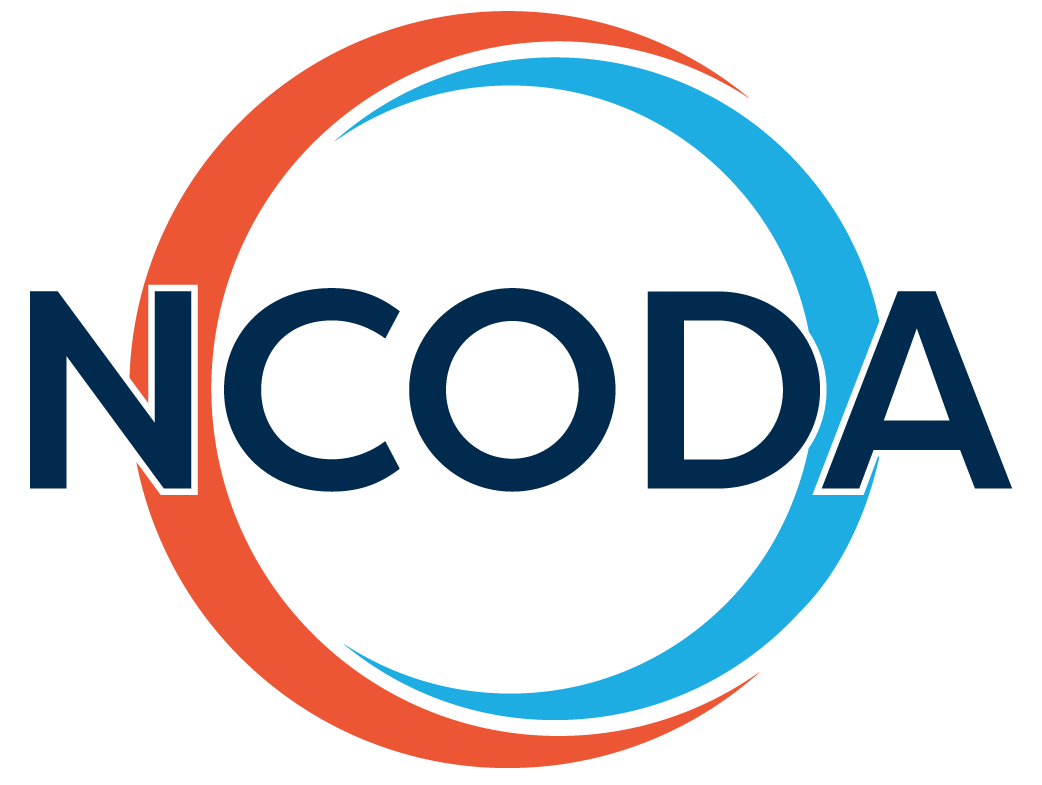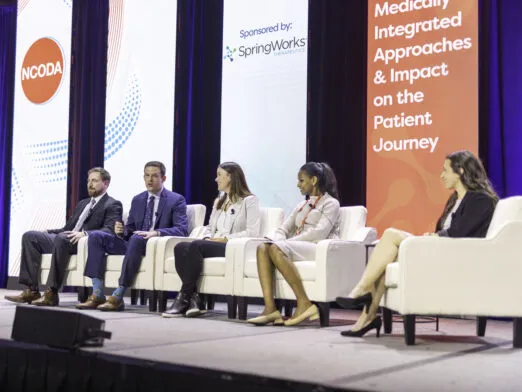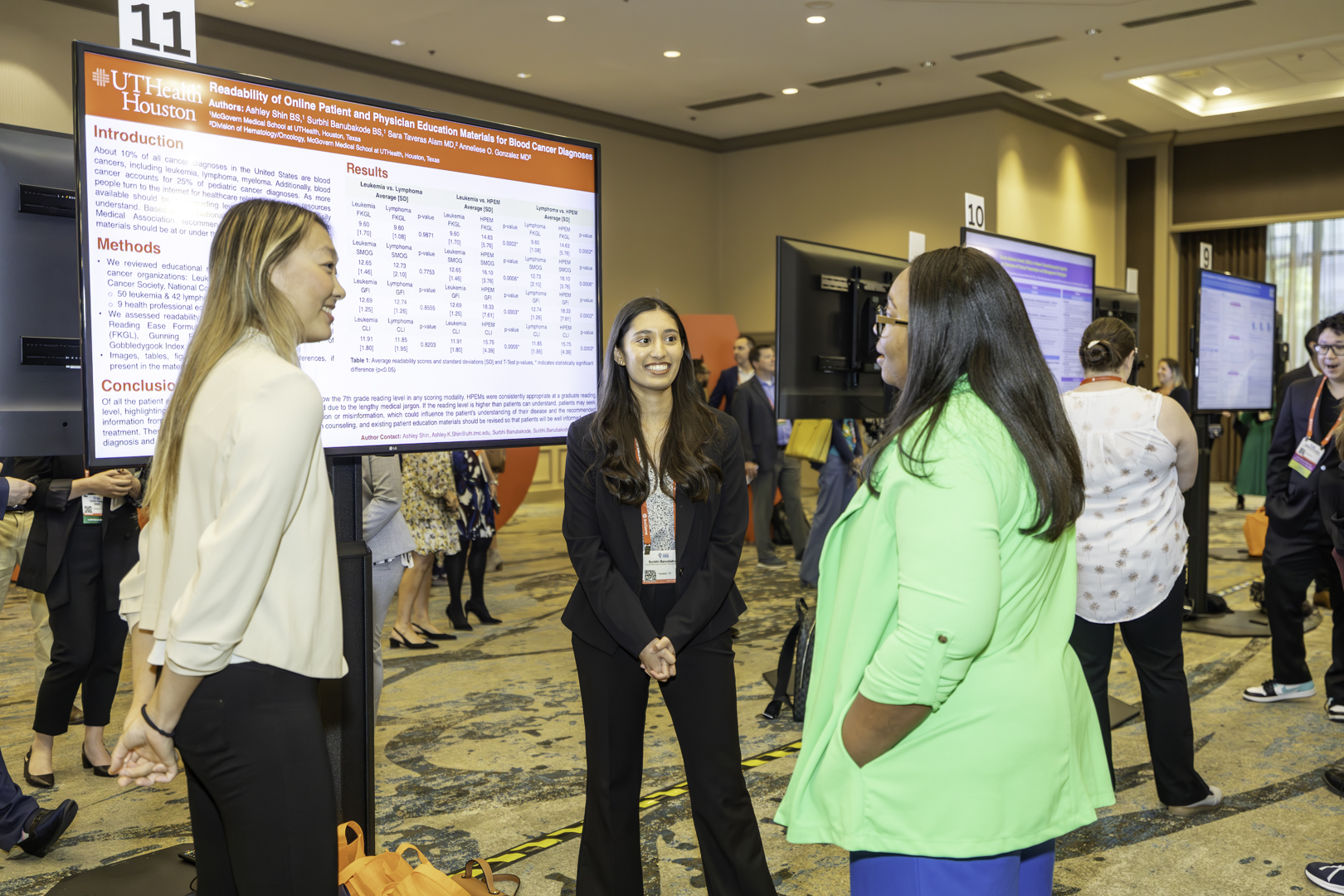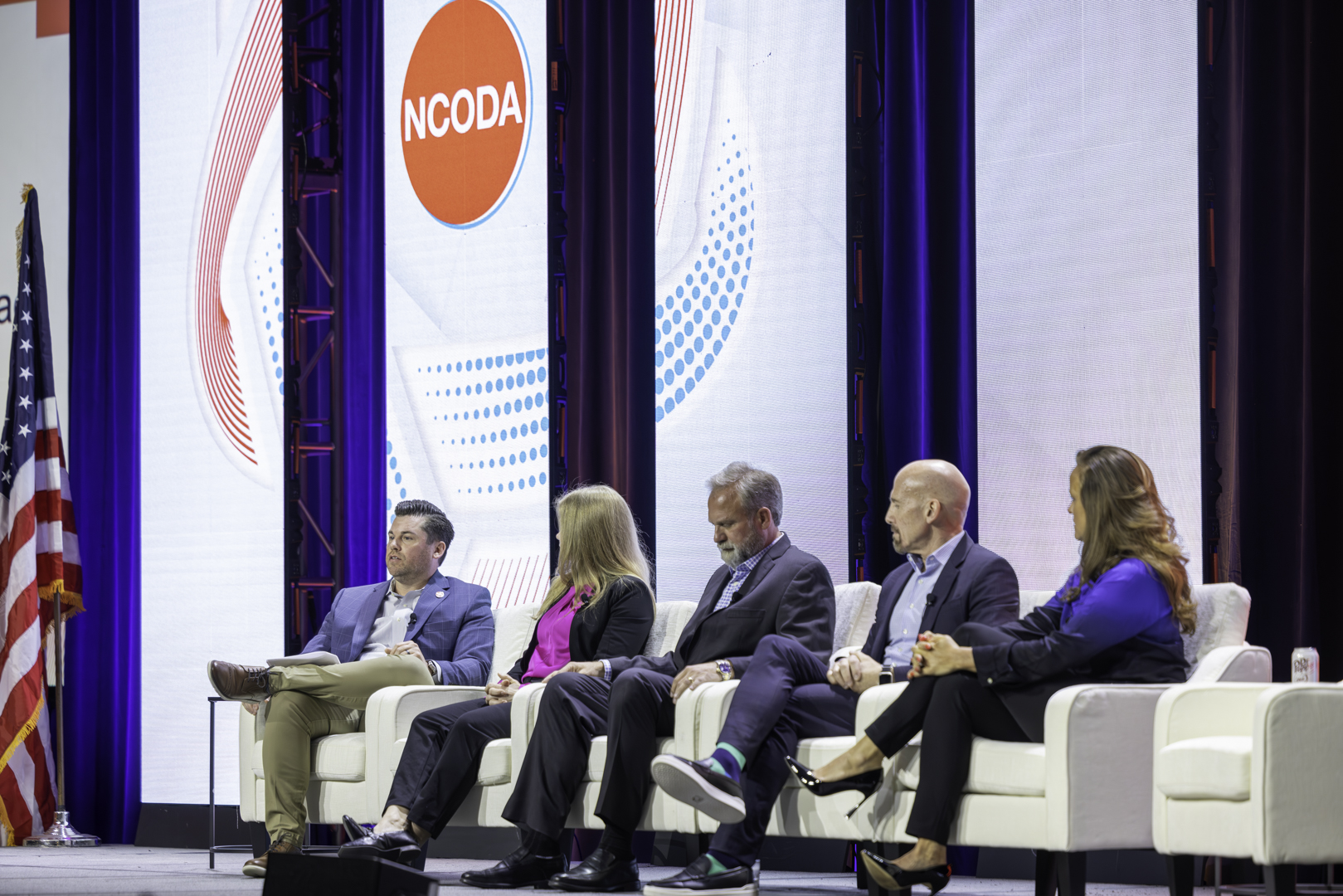OncolyticsToday: Advancing EGFR Therapy in Non-Small Cell Lung Cancer
Published Date: April 22, 2025

EVOLUTION OF TARGETED TREATMENT STRATEGIES AND THE PROMISE OF COMBINATION THERAPIES
Author: Virginia Velez Quinones, MD, Aala Dweik, MD, & Luis E. Raez, MD
Epidermal growth factor receptor (EGFR), a membrane-bound receptor tyrosine kinase, is overexpressed in approximately 40% to 80% of non-small cell lung cancer (NSCLC) cases, and, according to a systemic review and meta-analysis, the prevalence of EGFR mutations in NSCLC patients is approximately 32.3% globally.1 Additionally, National Comprehensive Cancer Network (NCCN) guidelines indicate that EGFR mutations are found in up to 10% of Non-Hispanic White patients, 19% of Black patients and 50% of Asian patients with NSCLC.2
Upon activation of EGFR by its ligands, signaling pathways responsible for cell growth, survival, and metastasis are initiated. The most common mutations in the EGFR gene, exon 19 deletions and the L858R mutation in exon 21, account for approximately 85% to 90% of all EGFR mutations in NSCLC. These mutations result in the continuous activation of the receptor, promoting cancer development in NSCLC patients.
Targeted treatment with EGFR tyrosine kinase inhibitors (TKIs) as first-line therapy is a cornerstone in the treatment of EGFR-mutated NSCLC and showed superior efficacy when compared to traditional chemotherapy, especially in individuals with specific EGFR mutations.3,4
EVOLUTION OF EGFR THERAPY WITH TKIS FROM GEFITINIB TO OSIMERTINIB
In the early 2000s, multiple studies served as milestones in developing EGFR-targeted therapy in NSCLC, specifically gefitinib and erlotinib, which are now classified as first-generation TKIs. These agents selectively inhibit the tyrosine kinase activity of EGFR, which is crucial for tumor cell growth and survival. They proved especially effective in patients with exon 19 deletions and the L858R point mutation in exon 21, leading to high response rates (ORR) and extended progression-free survival (PFS) for those with these mutations.
In 2004, two studies revealed that mutations in the EGFR tyrosine kinase domain were strongly linked to sensitivity to gefitinib in patients with advanced NSCLC, marking the beginning of personalized treatment for NSCLC, where treatment decisions were guided on the presence of specific genetic alterations.1,5-7 The BR.21 randomized, placebo-controlled trial showed that erlotinib significantly improved overall survival (OS), PFS, and ORR in patients with advanced NSCLC compared to a placebo. It also had a favorable adverse effect profile, which led to its approval by the U.S. Food and Drug Administration (FDA) in 2005.8
Subsequently, the IPASS clinical trial, conducted between 2006 and 2007, compared gefitinib versus carboplatin/ paclitaxel as first-line treatments in advanced NSCLC. Gefitinib demonstrated significantly improved PFS compared to carboplatin/paclitaxel in patients with EGFR mutation-positive NSCLC with a 26% reduction in the risk of progression or death in gefitinib-treated patients.
Between 2008 and 2010, the OPTIMAL trial demonstrated that erlotinib had significantly improved PFS and an ORR of 83% when compared to chemotherapy, which had a 36% response rate, in advanced NSCLC harboring EGFR mutations.9,10 These advancements solidified EGFR-TKIs as first-line therapy for advanced, EGFR-mutated NSCLC and drove the development of later generations of targeted therapies.
Despite the initial success of first-generation TKIs like gefitinib and erlotinib, resistance to these agents commonly develops within nine to 12 months of treatment initiation. This is secondary to resistance mechanisms, particularly the T790M mutation (exon 20) which is specifically targeted by osimertinib, a third-generation TKI.10-12
More uncommon resistance mechanisms arising from mutations like G719X (exon 18), S7681 (exon 20) and L861Q (exon 21) have varying responses to second- (afatinib/dacomitinib) and third-generation (osimertinib) TKIs.13 These findings necessitated further research and newer therapeutic strategies. Between 2014 and 2017, the FLAURA trial, a phase III, double-blind, randomized study, was conducted to address the resistance mechanisms associated with first-generation EGFR TKIs, gefitinib and erlotinib. It compared the efficacy and safety of osimertinib with first-generation TKIs in untreated patients with metastatic stage IV NSCLC harboring EGFR mutations (exon 19 deletions or L858R point mutations).
Osimertinib significantly improved PFS with a median of 18.9 months compared to 10.2 months in the comparator group alongside a superior safety profile when compared to first-generation TKIs.14,15 Furthermore, resistance mutations including T790M (exon 20) are specifically targeted by osimertinib.16 As recommended by the NCCN guidelines, the results of the FLAURA trial established osimertinib as the preferred first-line treatment for EGFR-mutant advanced NSCLC.17
OTHER TKIs OUTSIDE THE WESTERN WORLD: ICOTINIB, DACOMITINIB & AUMOLETINIB
In parallel, several EGFR TKIs have been developed and approved outside the Western world, particularly in China, to address the diverse spectrum of EGFR mutations and resistance mechanisms. Among them are icotinib, dacomitinib and aumolertinib:
Icotinib is a first-generation EGFR TKI developed by Betta Pharmaceuticals Co. in China. Its approval was based on the ICOGEN trial, a randomized, double-blind, phase III study comparing icotinib with gefitinib in patients with advanced NSCLC.
The trial demonstrated that icotinib was non-inferior to gefitinib in terms of PFS, with a favorable safety profile.18 These findings led to its approval by the China Food and Drug Administration in 2011.
Dacomitinib is a second-generation, irreversible EGFR TKI. It is approved and utilized in China for the treatment of NSCLC with specific EGFR mutations. The approval was based on an ambispective cohort study that was conducted across two centers in China.19
Eligible participants were patients with metastatic or recurrent NSCLC harboring major uncommon EGFR mutations G719X, L861Q and S768I. The study found that dacomitinib demonstrated favorable activity with manageable toxicity in patients with NSCLC harboring major uncommon EGFR mutations.19
Aumolertinib, a third-generation EGFR TKI developed in China, was approved based on the APOLLO trial for EGFR T790M-positive NSCLC after prior EGFR TKI therapy. The median OS was 30.2 months (95% CI, 24.2-36.4), with a 24-month OS rate of 57.5% (95% CI, 50.8-63.6).20
In this trial, 33.6% (82) of patients continued treatment beyond progression. Molecular profiling in 42 patients at progression identified EGFR C797S (7 cases), EGFR L718Q (1 case), and bypass track aberrations (eight cases), including PIK3CA, JAK2, BRAF, KRAS mutations, HER2 amplification and FGFR3-TACC3 fusion. The most common resistance mechanisms were EGFR C797S and bypass track aberrations.20 These studies were pivotal in establishing the efficacy and safety profiles of icotinib, dacomitinib and aumolertinib, leading to their respective approvals in China for the treatment of EGFR-mutant NSCLC.
COMBINATION THERAPY AS A NEW STANDARD OF CARE: EVALUATING FLAURA 2 (OSIMERTINIB PLUS CHEMOTHERAPY) AND MARIPOSA (LAZERTINIB PLUS AMIVANTAMAB)
The 2017 FLAURA trial led to the development of FLAURA 2, a phase III study published in 2021, which compared osimertinib plus chemotherapy to osimertinib monotherapy in treatment-naïve patients with locally advanced or metastatic EGFR-mutant NSCLC. The combination therapy demonstrated a significant improvement in PFS, with a median PFS of 25.5 months versus 16.7 months with osimertinib monotherapy (HR 0.55; p < 0.0001), indicating a 44% reduction in risk progression.21
At 24 months, 57% (95% CI, 50 to 63) of the patients in the osimertinib– chemotherapy group and 41% (95% CI, 35 to 47) of those in the osimertinib group were alive and progression-free.21 PFS as assessed according to blinded independent central review was consistent with the primary analysis (hazard ratio, 0.62; 95% CI, 0.48 to 0.80).21 An ORR was observed in 83% of the patients in the osimertinib–chemotherapy group and in 76% of those in the osimertinib group; the median response duration was 24.0 months (95% CI, 20.9 to 27.8) and 15.3 months (95% CI, 12.7 to 19.4), respectively.21
The incidence of grade 3 or higher adverse events from any cause was higher with the combination than with monotherapy — a finding driven by known chemotherapy-related adverse events. The safety profile of osimertinib plus pemetrexed and a platinum-based agent was consistent with the established profiles of the individual agents. The phase III MARIPOSA study evaluated another third-generation TKI, lazertinib, plus the bispecific antibody amivantamab vs. osimertinib as a first-line treatment for locally advanced or metastatic EGFR-mutated NSCLC.
There was a significant improvement in PFS, with a median PFS of 23.7 months in the amivantamab–lazertinib group versus 16.6 months in the osimertinib group (HR=0.70; p<0.001), reducing the risk of progression or death by 30%.22 Among patients with a confirmed response (336 in the amivantamab– lazertinib group and 314 in the osimertinib group), the median response duration was 25.8 months (95% CI, 20.1 to could not be estimated) and 16.8 months (95% CI, 14.8 to 18.5), respectively.22
The most common grade 3 or higher adverse effects (10% or higher in any arm) included neutropenia, thrombocytopenia and anemia. EGFR-related toxic effects were dermatitis acneiform, diarrhea and paroniquia. Based on these results the prophylactic use of oral antibiotics, local antibiotics, chlorhexidine for nails and other local measurements are recommended with this regimen. The incidence of thromboembolic events was increased and now prophylactic anticoagulation is required at least for the first four months of therapy. The incidence of discontinuation of all agents due to treatment-related adverse events was 10% with amivantamab-lazertinib and 3% with osimertinib.22
THE FUTURE OF TARGETED THERAPY
The landscape of targeted therapy in non-small cell lung cancer is rapidly evolving, with novel treatment strategies emerging to overcome resistance and improve patient outcomes.
Promising approaches currently in clinical development are ivonescimab (SMT112), a PD-1/VEGF bispecific antibody, patritumab deruxtecan (HER3- DXd), an antibody-drug conjugate (ADC) targeting HER3, and telisotuzumab vedotin (Teliso-V), an ADC designed to target and treat c-Met-overexpressing NSCLC.
Ivonescimab (SMT112), is a novel PD-1/VEGF bispecific antibody currently in phase 3 trials for the treatment of NSCLC and other advanced malignancies.23 The mechanism of action involves simultaneous blocking of PD-1 and VEGF pathways aiming to enhance antitumor activity while potentially improving safety through its engineered Fc-null region.23
Clinical trial data indicate promising efficacy, particularly in NSCLC patients, with an ORR of up to 75% in some cohorts and durable responses.23 In combination with chemotherapy, ivonescimab has demonstrated a median PFS of 11 to 12.3 months in first-line NSCLC patients without EGFR/ALK alterations.23
However, safety concerns include a higher incidence of treatment-emergent adverse events (TEAEs), though these were largely manageable. Ongoing trials, including the HARMONi-3 and HARMONi studies, aim to further assess survival outcomes and confirm the clinical benefit of ivonescimab in NSCLC, especially EGFR-TKI resistant populations.
Patritumab deruxtecan is an ADC composed of a fully human anti-HER3 IgG1 monoclonal antibody attached to several topoisomerase I inhibitor payloads via tetrapeptide-based cleavable linkers. The HERTHENA-Lung01 Phase II trial investigated the efficacy and safety of patritumab deruxtecan (HER3-DXd) in patients with EGFR-mutated NSCLC who had progressed after EGFR TKI therapy and platinum-based chemotherapy.24 In this study, HER3-DXd demonstrated a confirmed ORR of 29.8% (95% CI, 23.9–36.2) with a median duration of response of 6.4 months and a median PFS of 5.5 months. Median OS was reported at 11.9 months.24
Efficacy was observed across diverse mechanisms of EGFR TKI resistance and HER3 expression levels, including in patients with nonirradiated brain metastases, where a CNS ORR of 33.3% was noted.24 The safety profile was manageable, with common adverse events including hematologic toxicities such as thrombocytopenia and neutropenia.24 The study concluded that HER3- DXd provided meaningful clinical benefit, supporting further evaluation in a Phase III trial (HERTHENA-Lung02).
Telisotuzumab vedotin (Teliso-V) is an ADC that targets c-Met protein overexpression, a frequent mechanism of resistance in EGFR patients.25 A phase 1B clinical trial (NCT02099058) enrolled patients with advanced EGFR-mutated, c-Met protein–overexpressing, non-squamous NSCLC who had progressed on prior osimertinib.
Patients received intravenous Teliso-V – 1.6mg/kg in a safety lead-in phase then escalated to 1.9mg/kg given every two weeks – plus oral osimertinib 80mg once daily.25 From a total of 38 patients who received Teliso-V plus osimertinib no dose-limiting toxicities were observed. The most frequent any-grade TEAEs were peripheral sensory neuropathy (50%), peripheral edema (32%) and nausea (24%). The most common grade 3/4 TEAEs were anemia (11%) and pulmonary embolism (8%). Five TEAEs led to death; none were reported as being related to Teliso-V or osimertinib. After a median follow-up of 7.4 months, ORR was 50% per independent central review (ICR) (DOR not reached), and median PFS per ICR was 7.4 months (95% CI: 5.4, NR).25
CONCLUSION
The treatment landscape for EGFR mutated NSCLC has grown tremendously since the target was initially discovered. Approved regimens in the adjuvant and palliative settings include single-agent EGFR TKIs as well as combinations of targeted and chemotherapy agents. Osimertinib monotherapy remains a mainstay in the treatment of patients with newly diagnosed metastatic disease while we wait for combination therapy survival data to mature.
While combining targeted agents amivantamab and lazertinib has shown promising advances in PFS, there is still more to learn in terms of toxicity management particularly of skin and infusion reactions. Research studies have highlighted the efficacy of the amivantamab–lazertinib combination, though the higher incidence of EGFR-related toxicities underscores the need for improved management strategies.
In this context, the potential FDA approval of a subcutaneous formulation of amivantamab and enhanced education on skin toxicity management — particularly through antibiotic prophylaxis and other interventions — could significantly improve patient outcomes.
Molecular testing is key in the management of EGFR patients from the beginning, as well as upon progression of disease to evaluate for the mechanisms of EGFR-treatment resistance. Newer agents including bispecific antibodies and ADCs may be key in treating EGFR-mutated NSCLC that has progressed on initial targeted therapy.
Additional Information
REFERENCES
1. Nana-Sinkam, S. P., Powell, C. A. (2013). Molecular biology of lung cancer: Diagnosis and management of lung cancer, 3rd ed: American College of Chest Physicians evidence-based clinical practice guidelines. Chest, 143(5 Suppl), e30S-e39S. https://doi.org/10.1378/chest.12-2346.
2. Zhang, Y. L., Yuan, J. Q., Wang, K. F., et al. (2016). The prevalence of EGFR mutation in patients with non-small cell lung cancer: A systematic review and meta-analysis. Oncotarget, 7(48), 78985-78993. https://doi.org/10.18632/oncotarget.12587.
3. Riely, G. J., Wood, D. E., Ettinger, D. S., et al. (2024). Non-small cell lung cancer, Version 4.2024, NCCN Clinical Practice Guidelines in Oncology. Journal of the National Comprehensive Cancer Network, 22(4), 249-274. https://doi. org/10.6004/jnccn.2204.0023.
4. Reck, M., & Rabe, K. F. (2017). Precision diagnosis and treatment for advanced non-small-cell lung cancer. New England Journal of Medicine, 377(9), 849-861. https://doi.org/10.1056/NEJMra1703413.
5. Pao, W., & Miller, V. A. (2005). Epidermal growth factor receptor mutations, small-molecule kinase inhibitors, and non-small-cell lung cancer: Current knowledge and future directions. Journal of Clinical Oncology, 23(11), 2556-2568. https://doi.org/10.1200/JCO.2005.07.799.
6. Lynch, T. J., Bell, D. W., Sordella, R., et al. (2004). Activating mutations in the epidermal growth factor receptor underlying responsiveness of non-small-cell lung cancer to gefitinib. New England Journal of Medicine, 350(21), 2129-2139. https://doi.org/10.1056/NEJMoa040938.
7. Paez, J. G., Jänne, P. A., Lee, J. C., et al. (2004). EGFR mutations in lung cancer: Correlation with clinical response to gefitinib therapy. Science, 304(5676), 1497-1500. https://doi.org/10.1126/ science.1099314.
8. Shepherd, F. A., Rodrigues Pereira, J., Ciuleanu, T., et al. (2005). Erlotinib in previously treated non-small-cell lung cancer. New England Journal of Medicine, 353(2), 123-132. https://doi. org/10.1056/NEJMoa050753.
9. Fukuoka, M., Wu, Y. L., Thongprasert, S., et al. (2011). Biomarker analyses and final overall survival results from a phase III, randomized, open-label, first-line study of gefitinib versus carboplatin/paclitaxel in clinically selected patients with advanced non-small-cell lung cancer in Asia (IPASS). Journal of Clinical Oncology, 29(21), 2866-2874.
10. Mok, T. S. K., Wu, Y. L., Ahn, M. J., et al. (2017). Osimertinib or platinum-pemetrexed in EGFR T790M-positive lung cancer. New England Journal of Medicine, 376(7), 629-640. https://doi. org/10.1056/NEJMoa1612674.
11. Maemondo, M., Inoue, A., Kobayashi, K., et al. (2010). Gefitinib or chemotherapy for non-small-cell lung cancer with mutated EGFR. New England Journal of Medicine, 362(25), 2380- 2388. https://doi.org/10.1056/NEJMoa0909530.
12. Jänne, P. A., Wang, X., Socinski, M. A., et al. (2012). Randomized phase II trial of erlotinib alone or with carboplatin and paclitaxel in patients who were never or light former smokers with advanced lung adenocarcinoma: CALGB 30406 trial. Journal of Clinical Oncology, 30(17), 2063-2069. https:// doi.org/10.1200/JCO.2011.40.1315.
C L I N I C A L R E V I E W
EFGR
CONTINUED FROM PREVIOUS PAGE
CONTINUED ON NEXT PAGE
13. Zhang, T., Wan, B., Zhao, Y., et al. (2019). Treatment of uncommon EGFR mutations in non-small cell lung cancer: New evidence and treatment. Translational Lung Cancer Research, 8(3), 302-316. https://doi.org/10.21037/tlcr.2019.04.12.
14. Ramalingam, S. S., Vansteenkiste, J., Planchard, D., et al. (2020). Overall survival with osimertinib in untreated, EGFR-mutated advanced NSCLC. New England Journal of Medicine, 382(1), 41-50. https://doi.org/10.1056/NEJMoa1913662.
15. Soria, J. C., Ohe, Y., Vansteenkiste, J., et al. (2018). Osimertinib in untreated EGFR-mutated advanced non-small-cell lung cancer. New England Journal of Medicine, 378(2), 113-125. https://doi.org/10.1056/NEJMoa1713137.
16. Gomatou, G., Syrigos, N., & Kotteas, E. (2023). Osimertinib resistance: Molecular mechanisms and emerging treatment options. Cancers (Basel), 15(3), 841. https://doi.org/10.3390/cancers15030841.
17. Riely GJ, Wood DE, Ettinger DS, et al. Non-Small Cell Lung Cancer, Version 4.2024, NCCN Clinical Practice Guidelines in Oncology. J Natl Compr Canc Netw. 2024;22(4):249-274. doi:10.6004/jnccn.2204.0023.
18. Shi Y, Zhang L, Liu X, et al. Icotinib versus gefitinib in previously treated advanced non-small-cell lung cancer (ICOGEN): A randomised, double-blind phase 3 non-inferiority trial. Lancet Oncol. 2013;14(10):953-961. doi:10.1016/S1470-2045(13)70355-3.
19. Li, H. S., Yang, G. J., Cai, Y., et al. (2022). Dacomitinib for advanced non-small cell lung cancer patients harboring major uncommon EGFR alterations: A dual-center, single-arm, ambispective cohort study in China. Frontiers in Pharmacology, 13, 919652. https://doi.org/10.3389/fphar.2022.919652.
20. Lu, S., et al. (2022). 1208P Final results of APOLLO study: Overall survival (OS) of aumolertinib in patients with pretreated EGFR T790M-positive locally advanced or metastatic non-small cell lung cancer (NSCLC). Annals of Oncology, 32, S962.
21. Planchard D, Jänne PA, Cheng Y, et al. Osimertinib with or without chemotherapy in EGFR-mutated advanced NSCLC. N Engl J Med. 2023;389(21):1935-1948. doi:10.1056/NEJMoa2306434. Epub November 8, 2023. PMID: 37937763.
22. Cho BC, Lu S, Felip E, et al. Amivantamab plus lazertinib in previously untreated EGFR-mutated advanced NSCLC. N Engl J Med. 2024;391(16):1486-1498. doi:10.1056/NEJMoa2403614.
23. Summit Therapeutics. Published September 28, 2023. https://www.smmttx.com/ivonescimab-smt112/.
24. Yu HA, Goto Y, Hayashi H, et al. (2023). HERTHENA-Lung01, a phase II trial of patritumab deruxtecan (HER3-DXd) in epidermal growth factor receptor–mutated non–small-cell lung cancer after epidermal growth factor receptor tyrosine kinase inhibitor therapy and platinum-based chemotherapy. J Clin Oncol. 2023; 41(35): https://doi.org/10.1200/JCO.23.01476.
25. Horinouchi H, Cho BC, Camidge DR, et al. Results from a phase 1b study of telisotuzumab vedotin in combination with osimertinib in patients with c-Met protein–overexpressing, EGFR-mutated locally advanced/metastatic non-small cell lung cancer (NSCLC) after progression on prior osimertinib. Ann Oncol. 2025. doi:10.1016/j.annonc.2025.01.001.






